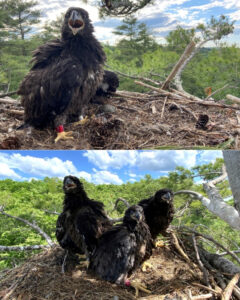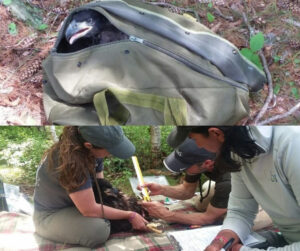(by Chris Martin)
During the final week in May, New Hampshire Audubon’s raptor biologist Chris Martin teamed with colleagues from the Biodiversity Research Institute (BRI) to examine, band, and obtain tissue samples from ten juvenile Bald Eagles at five productive nests in NH.

These sites included nests near NH Audubon’s Paradise Point Nature Center in Hebron and Massabesic Center in Auburn, as well as another at the Great Bay National Wildlife Refuge in Newington. At each location, a BRI climber ascended the nest tree, placed each eaglet in a sturdy duffle bag, and lowered it on a rope to the ground. The ground crew then weighed and measured each chick, placed unique ID bands on each leg, and obtained blood and feather samples which will be used for genetics and to assess contaminants like mercury and PFAS. In addition to the sites described here, four more nests (Bennington, Chesterfield, Dover, and Durham) were also visited. Nest phenology data collected by NH Audubon volunteer observers earlier in the season guided our site selection process. This endeavor was truly a team effort, and it will result in a better understanding of the impacts of toxins on eagles and add to our knowledge about eagle dispersal and longevity, too.

This work is permitted by both federal and State of NH wildlife agencies. Our thanks to land managers at the U.S. Fish and Wildlife Service and Manchester Water Works, and to several private landowners for allowing us to access nests located on their lands.
